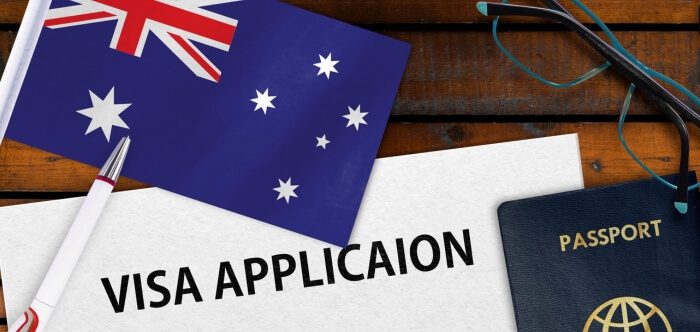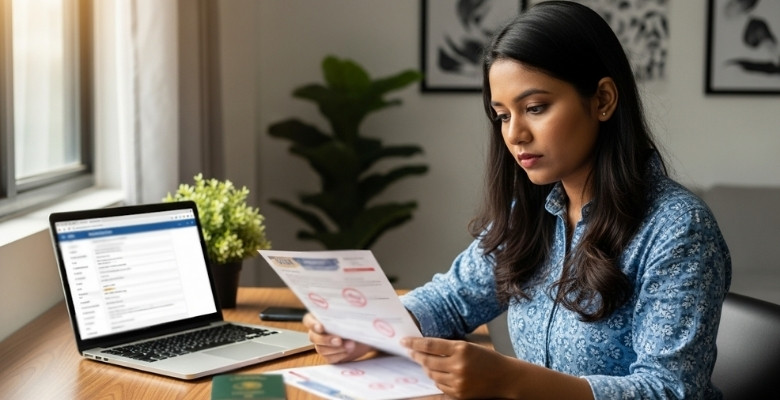Planning a visit to the United States often comes with many questions, and one of the most common is about invitation letters. These letters can make an application feel more complete by showing where you will stay and who you know in the country.
Knowing who can invite you to USA is an important first step before writing or requesting such a letter. Family, friends, companies, or even event organizers can all provide invitations, but what matters most is that the host is legally in the U.S. and can share the right supporting details.
An invitation letter doesn’t replace visa requirements, but it helps confirm the purpose of your trip in a clear way. By knowing who can issue one and what to include, you can approach your visa interview with more confidence and avoid unnecessary delays.
Who Can Invite You to USA?
Planning a trip to the United States often starts with one important question: who can officially invite you? While the invitation itself does not guarantee a visa, knowing who qualifies as a valid host makes the process clearer. Here’s a quick checklist of eligible inviters, followed by a breakdown of each role.
Quick Checklist of Eligible Hosts
- Family members (citizens, green card holders, lawful non-immigrants)
- Friends or acquaintances (with proof of lawful presence)
- Business partners or U.S. companies (meetings, conferences, trainings)
- Conference and event organizers (attendee/speaker confirmations)
- Schools and universities inviting visitors (e.g., graduation guests)
- Nonprofits and institutions (volunteering or collaboration)
Family Members
Family members are the most common hosts for U.S. visitors. Parents, siblings, cousins, or extended relatives can provide an invitation letter as long as they have legal status in the country. People often confuse this with sponsorship rules, asking questions like can a U.S. citizen sponsor a cousin for green card? While that is not possible under immigration law, a cousin who is legally in the U.S. can still invite you for a temporary visit through an invitation letter.
Friends or Acquaintances
Friends, including those you may know through personal or professional connections, can also send an invitation. Many people ask, can a friend invite me to USA? Yes, as long as they are lawfully present and can provide proof of their status. Likewise, can a U.S. citizen invite a friend? Absolutely, they can issue an invitation letter confirming the visit details and their willingness to host.
Business Partners or U.S. Companies
If your trip involves professional activities such as meetings, negotiations, or training, a U.S. company or partner can issue an invitation. These letters are usually written on company letterhead and clearly outline the purpose of the visit. This includes attending short-term meetings or even participating in conferences from overseas, as long as the activities are temporary and not actual employment in the U.S.
Conference and Event Organizers
Organizers of academic, cultural, or professional events can extend invitations to attendees, speakers, and panelists. Such invitations usually include event details, dates, and registration confirmations. They prove the traveler has a clear reason to enter the U.S. and will return after the event concludes.
Schools and Universities
Educational institutions often invite parents, guardians, or family members to attend student graduations or ceremonies. These letters typically include enrollment proof and event details. Schools also issue acceptance and enrollment documents for students, but for visitors, the invitation clarifies that the purpose of travel is family participation.
Nonprofits and Institutions
Nonprofit organizations, research institutes, or cultural institutions may invite individuals for volunteer projects, collaborations, or exchange programs. Their letters often highlight the mission, role of the visitor, and time frame. This form of invitation is especially powerful in cases tied to social good or cultural exchange.
Host Requirements: What the Inviter Should Provide?
Inviting someone to the U.S. comes with a few responsibilities for the host. It’s not complicated, but there are certain details you’ll want to have ready so the invitation letter looks complete and credible. Many people often ask, What documents do I need to invite someone to the USA? The answer is simple: it depends on the host’s status and the purpose of the visit. Let’s go through each of them step by step.
Proof of status
The very first thing a host should include is proof that they’re legally in the United States. This might be a U.S. passport, a green card, or even a copy of their visa with an I-94 record. This tells the authorities that the inviter is a real, verified resident.
U.S. address & contact details
Next, the host should clearly mention their full U.S. address and reliable contact information. That means phone number and email. It reassures consular officers that there’s a valid place for the visitor to stay and someone to contact if needed.
Trip specifics (dates, stay address)
It’s important to outline when the visitor will arrive, how long they’ll stay, and exactly where they’ll be living during the visit. These small but specific details show that the visit is well thought out rather than vague or open-ended.
Relationship/context proof
The invitation letter should also explain how the host and visitor know each other. Whether it’s family, friendship, or a business connection, adding proof like family records, old photos, or a business partnership note makes the relationship clear.
Host’s Financial Responsibility (if applicable)
If the host plans to cover some or all of the visitor’s expenses, they should fill out Form I-134 (Affidavit of Support) and attach recent bank statements, pay stubs, or tax returns. While this isn’t always required, it can give extra confidence to the visa officer.
Optional Extras (employment letter, lease/utility bill)
Some hosts also add extra supporting documents, like a letter from their employer to confirm their job, or copies of lease agreements and utility bills. These aren’t mandatory, but can make the letter stronger by showing stability and reliability.
Having these documents and details ready doesn’t just help the visitor—it also shows the U.S. authorities that the host is genuine and organized. The stronger the package, the smoother the process for everyone involved.
Visitor Requirements – What the Applicant Still Must Show?
Getting an invitation letter is helpful, but the real responsibility lies with the visitor. U.S. consular officers look at several personal factors before making a decision. These are things only the applicant can prove. Let’s take a closer look at what matters most.
Ties to home country
The visitor should show strong reasons to return home after the trip. This could be a steady job, business, property, or close family commitments. These ties assure officers that the visit is temporary and the applicant isn’t planning to overstay.
Sufficient funds
Proof of enough money to cover travel, accommodation, and daily expenses is critical. Bank statements, salary slips, or a sponsor’s financial documents can help. The goal is to show the applicant won’t face financial difficulties while in the U.S.
Truthful purpose
The visitor must clearly explain the purpose of the trip—whether it’s family, tourism, business, or an event. Being open and specific prevents confusion during the interview. A clear purpose builds confidence in the application.
Compliance history
Past travel behavior plays a big role. Applicants with a clean record of following visa rules and returning on time are viewed more positively. Any past overstays or violations can make the process much harder.
Invitation Letter
During the visa interview, the invitation letter works as supporting evidence. It helps confirm where the applicant will stay, who they know in the U.S., and the reason for the trip. Still, the officer will focus mainly on the applicant’s own documents and answers. It’s also worth noting that it is possible to apply for a US visa without an invitation letter, but having one often adds credibility to the application.
An invitation letter may strengthen the case, but it’s not enough on its own. The visitor’s ties, funds, and honesty matter the most. Keeping everything truthful and well-documented is the best way to improve the chances of approval.
What is the Purpose of the Invitation Letter?
When people talk about invitation letters for U.S. visas, it’s easy to think of them as the main requirement. In reality, they serve a supporting role. Their value lies in the details they provide, helping the consular officer understand the context of your visit. Let’s look at what the letter can and cannot do.
What it can do
An invitation letter helps explain the reason for your trip in clear terms. It shows who you will stay with, where you’ll be staying, and how long you plan to remain in the U.S. It can also include your host’s contact information so the embassy knows there’s a reliable point of reference. Together, these details create a fuller picture of your visit and add credibility to your application.
What it can’t do
A letter on its own cannot secure you a visa. The decision still rests on your personal eligibility, which includes your ties to your home country, financial readiness, past travel record, and truthful answers during the interview. Even the most well-written letter won’t replace these factors. Think of it as a helpful supplement, not the deciding factor.
The invitation letter is valuable because it makes your case more organized and easier to understand. Still, it’s just one part of the bigger picture. Keeping your documents complete and your story consistent is what really makes a difference.
How to Write a Strong Invitation Letter?
Once you know who can invite you to the USA, the next step is understanding how that invitation should actually be written. A clear and well-structured letter helps show your purpose, gives the officer confidence, and supports your visa application. Below are three common formats with templates you can download.
1. Family or Friend Invitation Letter (B-2 Visitor Visa)
A personal invitation from a relative or close friend is the most common type. It explains the purpose of the visit, where the guest will stay, and how long they’ll remain in the U.S.
Example –
[Your Full Name]
[Your U.S. Address]
[City, State, ZIP Code]
[Phone Number]
[Email Address]
[Date]
U.S. Embassy/Consulate
[City, Country]
Subject: Invitation for [Visitor’s Full Name, Passport No.]
Dear Consular Officer,
I am writing to invite my [relationship], [Visitor’s Full Name], to visit me in [City, State] from [arrival date] to [departure date]. During this time, they will stay at my residence at [full address].
I am a [U.S. citizen/permanent resident/visa holder], and a copy of my [passport/green card/visa + I-94] is attached. I will [cover/not cover] their travel and living expenses.
I assure you that [Visitor’s Name] will return to [home country] after their visit, as they have [job, family, studies, or other ties].
Sincerely,
[Signature]
[Printed Name]
2. Business Invitation Letter (B-1 Visa)
A business invitation is issued by a U.S. company or partner. It confirms the visitor’s role, the purpose of the trip, and assures that the visit is for professional reasons only, not employment.
Example –
[Company Letterhead]
[Date]
U.S. Embassy/Consulate
[City, Country]
Subject: Business Invitation for [Visitor’s Full Name, Passport No.]
Dear Consular Officer,
On behalf of [Company Name], I would like to invite [Visitor’s Name], [Title/Position],
from [Visitor’s Company, Country] to attend [meetings/conference/training] at our office
in [U.S. city] from [start date] to [end date].
The purpose of this visit is strictly business-related, and [Visitor’s Name] will not be
engaged in any employment in the United States. We will [cover/not cover] their travel
and accommodation costs.
Please find attached details of the event and company information for your review.
Sincerely,
[Authorized Signatory]
[Name, Title]
[Company Contact Information]
3. Conference Organizer Invitation Letter
Conference organizers use this type of letter to formally confirm a guest’s participation. It usually includes event dates, location, the role of the guest, and registration details.
Example –
[Organizer Letterhead]
[Date]
U.S. Embassy/Consulate
[City, Country]
Subject: Invitation to [Conference Name]
Dear Consular Officer,
This letter confirms that [Visitor’s Full Name, Passport No.] has been invited to attend
[Conference Name] held at [venue, city, state] from [dates]. [He/She/They] is registered
as a [attendee/speaker/panelist] under registration ID [number].
Please note this invitation is solely for conference participation. It does not provide any
immigration benefit or employment authorization.
Sincerely,
[Organizer Name]
[Title]
[Organization Contact Information]
These templates are designed to save time and make the process easier. Whether it’s family, business, or a conference, keeping the letter simple, direct, and supported with the right documents is always the best approach.
More Inviter Scenarios (Mini Guides + Micro-Checklists)
Not every U.S. visa invitation looks the same. The type of letter depends on who is inviting you and why you’re visiting. Each scenario has its own small requirements and supporting details that make the letter stronger. Let’s look at the most common cases one by one.
Student in the U.S. Inviting Parents for Graduation (Visitor B-2)
Students often invite parents to attend graduation ceremonies. If you’re wondering how to invite someone from another country for such an event, the steps remain the same – include ceremony details, enrollment proof, and the U.S. address of stay.
Mini checklist:
- Graduation date and venue
- Student’s enrollment/SEVIS proof
- Copy of Form I-20 (if applicable)
- Student’s U.S. address and contact
Medical or Compassionate Visits
When someone is invited for medical treatment or to support a relative, extra documents are usually required. Knowing how to invite someone to America in these cases means including hospital letters, treatment notes, and clear dates of stay in the invitation.
Mini checklist:
- Doctor’s letter or hospital appointment
- Treatment plan or medical proof
- Host’s contact details
- Dates of planned stay
Multiple Hosts or Multi-city Trips
If the visitor will stay with more than one host, each host should write a short letter covering their part of the trip. Together, these letters give a complete view of where the visitor will be staying.
Mini checklist:
- Individual letters from each host
- Dates and address for each stay
- Proof of status from each inviter
- Combined itinerary (optional but useful)
Each situation calls for slightly different details, but the idea is the same: show who is inviting you, why you’re visiting, and where you’ll stay. Clear and honest information always makes the invitation more reliable.
Conference-Specific Guidance (Your Advantage)
Conference invitation letters hold a unique role in U.S. visa applications. They differ from personal or business letters because they must clearly show event details and the applicant’s role in that event. Adding the right information makes the letter both professional and effective. Let’s go over what matters most.
What Event Letters Should Include
A good conference letter should list the event name, exact dates, venue, and city. It should also clearly mention the participant’s role—whether they are a registered attendee, a speaker, or a panelist. If available, adding a registration ID or confirmation number makes the letter stronger. Including a link to the event agenda or official website gives the officer an easy way to verify the details. If you’re planning to attend, you’ll need to get a conference invitation letter that covers all of these points.
Payment/registration status
The letter should state whether the attendee has paid their registration fees or if payment is pending. This avoids confusion and proves the registration is genuine. Organizers often also add a line confirming that the participant is officially recorded in the event database.
Non-sponsorship line
A simple but important detail is clarifying that the letter is not a sponsorship document. This tells the consular officer that the organizer is inviting the participant to join the event but is not providing financial support or immigration benefits.
Presenter vs attendee wording
If the participant is a speaker or presenter, the letter should highlight their session title, topic, and scheduled date. This shows their role is significant. If the person is an attendee, the wording should be simple, confirming their registration and participation without adding unnecessary claims.
Conference invitations need to be specific, clear, and professional. Adding these details avoids delays and makes the letter more reliable. If you’re organizing or attending an event, taking care of these small points can make the visa process much smoother.
Common Factors Affecting Visa Approval
Even with a strong invitation letter, the final decision always depends on the applicant’s overall profile. Consular officers look beyond the host’s details to see if the visitor meets key requirements. Knowing these factors helps you understand how an invitation actually fits into the bigger picture. Let’s go through the most important ones.
Ties to Home Country
Officers want to be sure the visitor will return home. A job, business, property, or close family responsibilities all count as strong ties. While an invitation letter shows where the visitor will stay, it’s these ties that prove the visit is temporary.
Financial Stability
Applicants need to show they can cover travel and living costs during their stay. Bank statements or proof of income are usually checked. If a host says they’ll help financially, attaching an affidavit of support or pay slips makes the invitation more credible.
Travel and Compliance History
A visitor with a record of following visa rules and leaving on time stands a better chance of approval. Past overstays or visa refusals, on the other hand, may raise red flags. An invitation helps, but it cannot erase a poor history.
Consistency of Information
All details must match, from the visa form to the invitation letter to what’s said in the interview. Any mismatch in dates, addresses, or travel purpose can create doubt. Consistency across documents is just as important as the invitation itself.
Invitation letters are useful, but they only strengthen an application when the basics are already in place. Strong ties, financial proof, good history, and consistent information work hand in hand with the letter to improve visa approval chances.
Myths, Red Flags, and Mistakes
When it comes to U.S. visa applications, invitation letters are often misunderstood. Many people either place too much weight on them or make small mistakes that weaken their case. Clearing up these myths and avoiding common errors can save both time and stress. Let’s look at the key points you should know.
Myth: An Invitation Guarantees a Visa
One of the biggest misconceptions is that having an invitation letter means automatic approval. The truth is, officers decide based on the applicant’s own situation—ties, funds, and past record, not just the letter.
Mistake: Thinking Notarization is Always Required
Some hosts assume that the invitation must be notarized to be valid. In most cases, a simple signed letter is enough. Notarization only matters if specifically requested by the embassy handling the case.
Mistake: Confusing I-134 with I-864
These two forms serve different purposes. I-134 is used for temporary visits, while I-864 is tied to permanent immigration sponsorship. Mixing them up can create confusion or even weaken an application.
Red Flag: Vague Dates or Unclear Purpose
Letters that only say “visit soon” or “stay for some time” raise concerns. Dates, purpose, and length of stay should be clear. Specific information always looks more reliable.
Red Flag: Missing Host Proof
If the host doesn’t include proof of their U.S. status or address, the letter loses weight. These attachments are what show the host is legitimate.
Red Flag: Inconsistent Details
When the invitation letter says one thing, the DS-160 form says another, and the applicant says something different in the interview, doubts arise quickly. Consistency across all information is key.
Invitation letters help, but only when they are written clearly, supported with the right documents, and aligned with the visitor’s application. Avoiding these myths and mistakes ensures the letter works as a supporting tool instead of a stumbling block.
FAQs
Even after reading through everything about invitation letters and visa requirements, many people still have small but important questions. Here are some unique FAQs that clear up common doubts and give you straightforward answers.
Can an Invitation Letter Be Sent By Email Instead of Post?
Yes, an emailed invitation letter is generally acceptable. As long as the content is clear, signed, and includes supporting documents, it works fine. A printed copy is useful, but not mandatory in most cases.
Should the Invitation Letter Be Written in English Only?
Yes, it should be in English, since that’s the official language used by U.S. embassies and consulates. If the inviter speaks another language, they should still provide the English version. This avoids translation delays.
Can I Use the Same Invitation Letter for Multiple Visits?
No, each visit should have its own letter with specific dates and details. Reusing an old letter creates confusion during the interview. Officers prefer updated information that matches the purpose of each trip.
Does the Invitation Letter Need to Include My Passport Number?
Yes, adding the visitor’s passport number is a good practice. It helps match the letter directly with the applicant’s visa file. It’s not mandatory, but it adds clarity to the application.
Can a Minor Invite Their Parents to the U.S.?
No, minors cannot issue formal invitations since they don’t have the required legal status. Parents usually visit by showing school or university documents instead. Only adult students or hosts can provide such letters.
What Happens If the Invitation Letter Has Mistakes?
Small errors like typos can be overlooked, but major mistakes in dates or names may cause problems. It’s best to double-check every detail before submission. Consistency across all documents is very important.
Is It Necessary for the Invitation Letter to State Daily Expenses?
Not always, but if the host is covering food and living costs, it helps to mention it briefly. If not, the visitor should show proof of personal funds. This avoids financial doubts during the review.
Concluding Words
It’s clear that invitation letters play an important supporting role in the U.S. visa process. They help connect the applicant’s story with a real person, company, or institution already in the country.
When you understand who can invite you to USA, it becomes easier to prepare the right documents and avoid confusion. The right host combined with accurate details can make your application look more reliable to the officer.
Still, remember that an invitation is only one piece of the overall process. What truly matters is combining it with honest answers, strong ties to your home country, and clear supporting documents during your visa interview.












